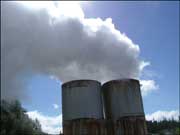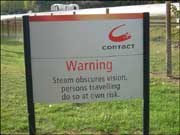4. Dry Steam, Wet Steam, Water and Ice
The Three States of Water
The compound H2O can occur in three states
- When in a solid state it is called ice
- When in a liquid state it is called water
- When in a gaseous state it is colourless, odourless and called steam. (Note : the white clouds seen around boiling water are tiny water droplets, called water vapour, not steam).
Like all matter, the temperature at which H2O changes from one state to another depends on the pressure and its purity.
Water freezes (or melts) at 0°C but only when it is
- Pure water. Dissolved salts in water lower the melting point and raise the boiling point of water.
- At sea level. The pressure at sea level is called 'one atmosphere' or 'one bar'. Higher pressures raise the boiling point and lower pressures decrease the boiling point.
For example
- Weather changes alone can alter the boiling point of water at sea level, by 3 degrees
- On top of Mt Everest the reduced air pressure means water boils at 68°C.
- The altitude of Wairakei is 370m above sea level, which means water boils at 98.7°C here
- Underground pressures may be so high that even at 374°C water remains a liquid. Above 374°C water is indistinguishable from steam.
What is temperature?
The temperature of water can be measured by using a thermometer, but the temperature reading is only a guide to the average speed of the water molecules. The higher the temperature the faster the molecules are moving.
For example
In a 20°C room the average speed of the air molecules is about 330 metres per second. In a household freezer this average speed drops to about 300 metres per second.
However because the measurement is of the average speed - some molecules are moving faster and some slower.
For example
Within a glass of water some molecules are moving slow enough to freeze while others are moving fast enough to boil. As some boil, they leave the glass and the water level drops. This is commonly explained as "the water has evaporated".
Dry Steam
Dry steam has all of its water molecules in the gas state.
Dry Steam is important in thermal power generation because even the tiniest
water droplets can damage turbine blades.
Flashed Steam
Flashed steam is steam that has been created by a pressure drop rather than a temperature rise. Flashed steam is usually made by allowing hot water to escape into a lower pressure vessel. The Flashed steam can then be used to drive turbines and generators.




